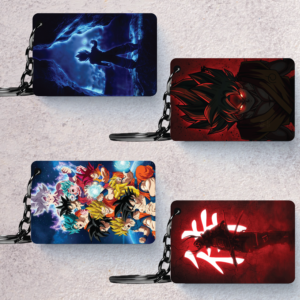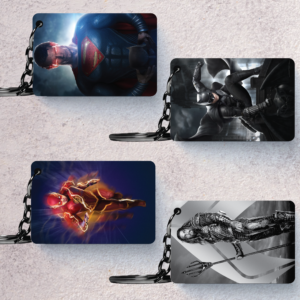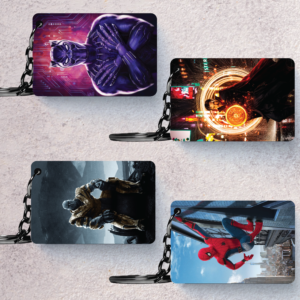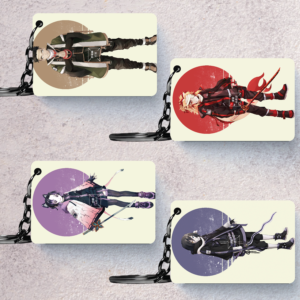Introduction
“Embarking on the journey of marriage is a cherished tradition in India, where weddings are not just ceremonies but grand celebrations of love and culture. Central to this celebration are the bride and groom, who are adorned in exquisite attire that reflects the rich heritage and evolving fashion sensibilities of the country. From traditional to contemporary, the fashion trends for Indian brides and grooms encapsulate a beautiful blend of timeless elegance and modern flair, making each wedding a spectacle of style and tradition intertwined.”
Traditional vs. Modern Trends
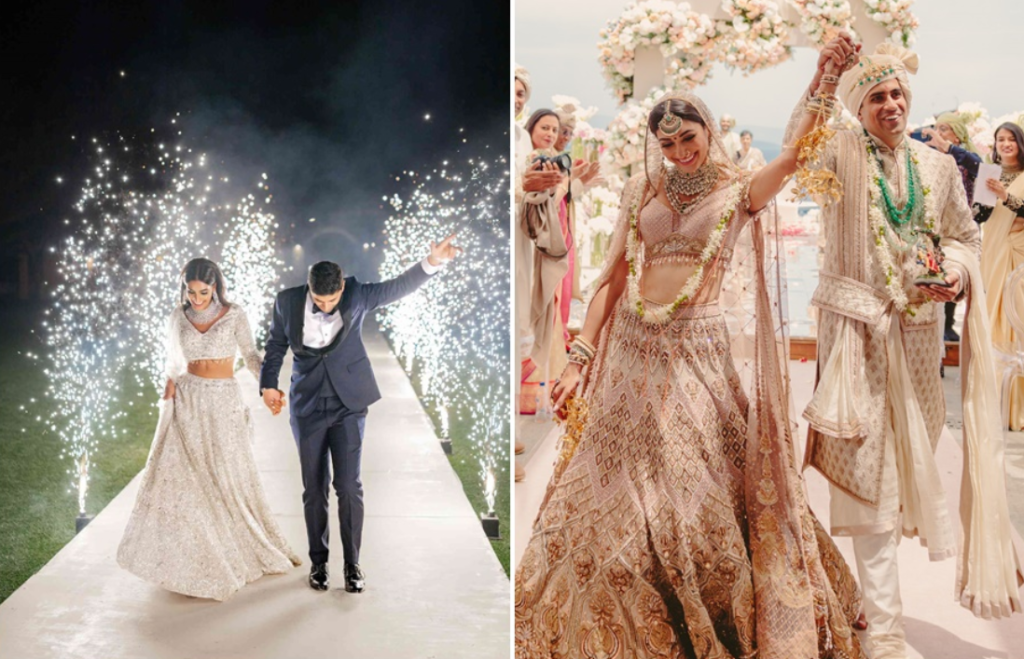
Traditional and modern trends for Indian brides and grooms reflect a fascinating blend of cultural heritage and contemporary influences. Traditionally, Indian weddings are rich in customs and rituals, with elaborate ceremonies spanning several days. For brides, traditional attire like the vibrant saree or lehenga, adorned with intricate embroidery, jewels, and mehndi (henna), symbolizes cultural richness and beauty. Grooms often wear traditional outfits like the sherwani or kurta, complemented by a turban or stole, showcasing elegance and masculinity. However, modern trends are reshaping these conventions. Contemporary Indian brides are embracing fusion wear, opting for Indo-western outfits or designer gowns, experimenting with bold colors and unconventional styles, yet still incorporating traditional jewelry and henna art. Grooms, too, are exploring modern fashion with tailored suits, fusion ensembles, and trendy accessories, blending sophistication with cultural heritage. Moreover, wedding themes, venues, and ceremonies are evolving, with couples incorporating technology for virtual guests, destination weddings, and personalized touches, reflecting a harmonious fusion of tradition and modernity in Indian matrimonial celebrations.
Bridal Fashion Trends
North India
Bridal fashion trends in North India are a vibrant blend of traditional aesthetics and contemporary influences, reflecting a rich cultural heritage while embracing modern styles. Lehengas continue to reign supreme as the quintessential bridal attire, with intricate embroidery, luxurious fabrics like silk and velvet, and opulent embellishments such as zardozi work and Swarovski crystals. Pastel shades are making a mark alongside traditional reds and maroons, offering brides a spectrum of choices to suit their preferences. Intricately designed cholis and dupattas adorned with sequins, beads, and thread work add a touch of glamour to the ensemble. Bridal jewelry complements these outfits with elaborate designs featuring Kundan, Polki, and Meenakari work, often paired with statement pieces like matha pattis, chokers, and oversized earrings. Contemporary elements such as fusion wear incorporating Western silhouettes or Indo-Western gowns are also gaining popularity, providing brides with versatile options for different wedding functions. Overall, North Indian bridal fashion showcases a delightful fusion of tradition and innovation, making every bride’s journey to the altar a glamorous and memorable affair.
South India
Bridal fashion in South India is a vibrant tapestry of tradition and modernity, constantly evolving yet deeply rooted in cultural significance. Traditional South Indian bridal attire often features rich silk sarees, such as Kanchipuram, with intricate gold zari work, vibrant colors, and traditional motifs like peacocks, temple designs, and mango motifs. These sarees are paired with ornate gold jewelry sets, including necklaces, earrings, bangles, and waistbands, often showcasing exquisite craftsmanship and intricate detailing. However, contemporary trends have also made their mark, with brides opting for fusion ensembles that blend traditional elements with modern silhouettes, fabrics, and embellishments. Pastel hues, floral motifs, and lightweight fabrics like chiffon and georgette are gaining popularity, offering a refreshing take on bridal fashion while retaining the essence of South Indian aesthetics. Additionally, experimentation with blouse designs, incorporating intricate embroidery, embellishments, and unconventional cuts, adds a modern flair to the traditional attire. Accessories like maang tikka, nose rings, and anklets complete the bridal look, reflecting a harmonious balance between tradition and contemporary style, making South Indian bridal fashion a captivating blend of heritage and innovation.
East India
Bridal fashion trends in East India reflect a beautiful blend of traditional heritage and modern aesthetics, creating stunning ensembles that captivate with their intricate designs and vibrant colors. One of the notable trends is the resurgence of traditional weaves like Benarasi silk, Kanjeevaram, and Dhakai Jamdani, infused with contemporary cuts and embellishments. Lehengas adorned with intricate zardozi, threadwork, and sequins continue to be a favorite, complemented by elaborate dupattas featuring intricate borders and motifs. Sarees, a timeless favorite, are being reinvented with modern draping styles and innovative blouse designs, such as off-shoulder and peplum blouses, adding a touch of modernity to the traditional attire. Bridal jewelry is another essential aspect, with a shift towards statement pieces like chokers, matha pattis, and oversized earrings, often incorporating precious stones and intricate craftsmanship. Makeup trends lean towards a balance of traditional bridal looks with a contemporary twist, focusing on flawless skin, bold eyes, and statement lips. Overall, East Indian bridal fashion celebrates a rich cultural heritage while embracing modern influences, creating a stunning and diverse array of bridal looks that are both timeless and fashionable.
West India
Bridal fashion trends in West India reflect a beautiful amalgamation of traditional aesthetics and modern influences, creating a unique and captivating style for brides. One of the prominent trends is the revival of classic handcrafted textiles such as Banarasi silk, Paithani, and Bandhani, showcasing intricate patterns and vibrant colors that symbolize the rich cultural heritage of the region. Bridal outfits are often adorned with exquisite embroidery work, including zardozi, gota patti, and mirror work, adding a touch of opulence and glamour. Contemporary silhouettes like lehengas with crop tops, fusion sarees, and Indo-western gowns have gained popularity, offering brides a variety of options to express their personal style while staying rooted in tradition. Accessories play a significant role, with brides opting for statement jewelry pieces like chokers, maang tikas, and haath phools that complement their attire and enhance their bridal look. Makeup trends lean towards a balance of traditional and modern elements, with emphasis on radiant skin, bold eyes, and soft, natural lips, creating a timeless bridal glow. Overall, bridal fashion in West India continues to evolve, embracing the old and the new to create enchanting ensembles that captivate hearts and define cultural elegance.
Groom Fashion Trends
Groom fashion trends have evolved significantly in recent years, reflecting a blend of traditional elegance and modern style. Classic tuxedos and suits remain timeless choices, often in shades of black, navy, or charcoal, but with contemporary twists such as slim-fit silhouettes and unconventional fabrics like velvet or tweed. Customization plays a key role, with many grooms opting for personalized details such as monogrammed cuffs, contrasting lapels, or unique button designs. The influence of cultural heritage is also prominent, seen in the resurgence of traditional ethnic attire like sherwanis, kurtas, or kilts, which are often paired with bespoke accessories like embroidered stoles, ornate turbans, or intricately designed brooches. In terms of color palettes, neutrals continue to dominate, but there’s a growing preference for muted pastels, deep jewel tones, or even bold, unconventional colors for those seeking a distinctive statement. Accessories play a crucial role in completing the look, with leather shoes, stylish watches, and classic ties or bowties remaining staples, alongside newer additions like pocket squares, lapel pins, and statement cufflinks. Overall, groom fashion today is a harmonious fusion of heritage, personal style, and contemporary trends, offering a diverse range of choices for every groom’s unique taste and wedding theme.
Seasonal Trends
Seasonal trends in Indian weddings showcase a vibrant tapestry of cultural traditions intertwined with contemporary influences, reflecting the diverse landscapes and climates across the subcontinent. The wedding season typically peaks during winter, from November to February, when cooler temperatures prevail, making outdoor celebrations more comfortable, especially in the northern regions. This period sees a flurry of extravagant ceremonies, with venues adorned in rich hues of maroons, golds, and greens, reflecting the opulence and warmth of the season. In contrast, summer weddings, occurring from March to June, are characterized by lighter fabrics, pastel color palettes, and tropical motifs, mirroring the lushness of the monsoon season that follows. Monsoon weddings, prevalent from July to September, embrace the romanticism of rain showers, with decor elements like umbrellas, floral canopies, and vibrant rain-themed backdrops creating a whimsical ambiance. Autumn weddings, from September to November, witness a blend of traditional and modern aesthetics, with earthy tones, rustic decor, and outdoor venues showcasing the beauty of the changing seasons. Each season brings its unique charm and essence to Indian weddings, highlighting the country’s rich cultural heritage and the adaptability of its celebratory customs to the natural rhythms of the year.
Celebrity Inspirations
Celebrity inspirations in Indian weddings have been a significant trendsetter, influencing everything from fashion choices to ceremony styles. From lavish destination weddings to intimate affairs, Bollywood celebrities like Deepika Padukone and Ranveer Singh’s picturesque Italian wedding set new standards of grandeur and elegance, inspiring couples to opt for exotic locations and opulent decor. Priyanka Chopra and Nick Jonas’s cross-cultural wedding festivities showcased the beauty of blending traditions, encouraging couples to embrace multicultural elements in their ceremonies. Virat Kohli and Anushka Sharma’s private Tuscan wedding emphasized the appeal of simplicity and intimacy, leading to a rise in small, personalized weddings among celebrities and commoners alike. These high-profile weddings have not only shaped wedding trends but also promoted inclusivity, creativity, and individuality in celebrating love and commitment.
Innovations in Fabric and Design
Innovations in fabric and design in Indian weddings have witnessed a remarkable evolution, blending traditional craftsmanship with modern sensibilities. The Indian wedding industry has embraced a fusion of traditional textiles like silk, brocade, and velvet with contemporary fabrics such as georgette, chiffon, and organza, creating a rich tapestry of textures and colors. Designers are experimenting with intricate embroideries like zardozi, gota patti, and thread work, seamlessly integrating them into bridal wear and groom’s attire. The advent of digital printing and 3D embellishments has added a new dimension to bridal ensembles, offering a plethora of customizable options for brides and grooms. Furthermore, sustainable and eco-friendly fabrics like khadi, bamboo silk, and organic cotton are gaining popularity, reflecting a shift towards conscious fashion in the wedding industry. Innovations in fabric and design not only reflect the cultural heritage of India but also showcase the nation’s dynamic and evolving fashion landscape on a global stage, making Indian weddings a celebration of creativity, craftsmanship, and sustainability.
Jewellery and Accessories
Jewellery and accessories play a paramount role in Indian weddings, reflecting the country’s rich cultural heritage and traditional values. From intricate gold and diamond sets to elaborate silver ornaments, Indian brides adorn themselves with a dazzling array of jewellery, each piece holding significance and symbolism. The choice of jewellery varies across different regions, with South Indian brides favoring temple jewellery featuring motifs of gods and goddesses, while North Indian brides often opt for Kundan and Polki sets known for their intricate designs and use of precious stones. Accessories such as maang tikka (forehead ornament), nose ring, bangles, anklets, and waistbands complete the bridal ensemble, enhancing the bride’s beauty and elegance. These jewellery pieces are not just decorative but also hold emotional and familial value, often passed down through generations as heirlooms, adding a layer of sentimental value to the wedding attire. In recent years, there has been a fusion of traditional and contemporary styles, with brides experimenting with modern designs while staying rooted in their cultural heritage, showcasing the evolving trends in Indian bridal jewellery and accessories.
Tips for Choosing the Right Outfit
Choosing the perfect outfit for an Indian wedding can be both exciting and overwhelming, considering the diverse cultural and style variations across regions and ceremonies. Begin by understanding the wedding’s specific dress code, whether it’s a traditional affair like a Sikh, Hindu, or Muslim wedding, or a fusion event blending modern and traditional elements. Pay attention to the venue and time of day, as these factors influence your attire’s formality and color choices. Opt for fabrics that are comfortable yet elegant, such as silk, chiffon, or georgette, to withstand long ceremonies and festivities. Consider the season as well; lighter fabrics and pastel colors are ideal for summer weddings, while richer tones and heavier textiles suit winter celebrations. Pay close attention to embellishments and embroidery, ensuring they complement the overall look without overpowering it. Accessories like jewelry, footwear, and handbags should also harmonize with your outfit, adding a touch of sophistication and cultural flair. Finally, don’t forget to factor in your personal style and comfort level; confidence in your outfit choice will make you shine throughout the wedding festivities.
Cultural Significance
Indian weddings are not just ceremonies but grand cultural celebrations steeped in tradition and significance. They embody a rich tapestry of cultural elements that vary widely based on region, religion, and community, yet share common threads that bind them together. From the vibrant colors of attire to the intricate Mehendi designs adorning the hands of the bride, every aspect carries deep symbolic meaning. Rituals like the Saptapadi, where the couple takes seven steps together around a sacred fire, symbolize their journey through life’s seven stages. The exchange of garlands signifies mutual acceptance and respect, while the Mangalsutra represents the eternal bond between husband and wife. Music and dance, whether it’s the energetic beats of the dhol or the graceful movements of classical dances like Bharatanatyam, add joy and festivity to the occasion. Food plays a pivotal role, with elaborate feasts showcasing regional delicacies and culinary traditions. The coming together of families, relatives, and friends fosters social bonds and strengthens community ties. Overall, Indian weddings are not just about union but serve as a reflection of India’s diverse cultural heritage and the values that bind families and communities together.
Sustainable Fashion in Weddings
Sustainable fashion in Indian weddings has emerged as a significant trend, reflecting a growing awareness of environmental and social responsibility among couples and designers alike. Traditional Indian textiles and techniques, such as handloom weaving, block printing, and natural dyeing, are being revitalized and integrated into modern wedding attire, fostering a revival of heritage crafts and supporting local artisans. Designers are incorporating sustainable practices into their collections by using organic and recycled materials, reducing waste through innovative design, and promoting fair labor practices. This shift towards sustainability is also influencing wedding ceremonies, with couples opting for eco-friendly décor, locally sourced flowers, and ethical catering options. Moreover, the concept of reusing and repurposing wedding outfits is gaining traction, encouraging a more mindful approach to fashion consumption. As sustainability becomes a key focus in Indian weddings, it not only adds a unique and conscious element to celebrations but also contributes positively to the environment and community, setting a meaningful example for future generations.
Wedding Trends in Different Seasons
Wedding trends in different seasons in India vary widely, reflecting the country’s rich cultural diversity and regional influences. In the winter season, which spans from November to February, weddings often feature luxurious and opulent themes, with rich color palettes like deep reds, royal blues, and emerald greens. Traditional attire such as intricate embroidered lehengas and sherwanis is popular during this time. Spring weddings, from March to May, are characterized by vibrant and pastel hues, floral motifs, and lightweight fabrics like chiffon and georgette. Outdoor venues such as gardens and beach resorts are preferred for their natural beauty. Summer weddings, spanning from June to September, lean towards lighter colors, breezy fabrics like cotton and linen, and minimalistic decor to beat the heat. Monsoon weddings in July and August embrace the romantic rainfall with tented venues, umbrellas as props, and a cozy ambiance. Each season brings its own charm to Indian weddings, showcasing the country’s colorful traditions and evolving preferences in celebration styles.
Fashion Dos and Don’ts
When it comes to fashion dos and don’ts for Indian weddings, there are several key points to keep in mind. Dos include opting for traditional attire like sarees, lehengas, or Anarkali suits for women, and sherwanis or bandhgalas for men, as they reflect the cultural essence of the event. Choosing vibrant colors such as red, maroon, gold, or pastels is a good idea, as they symbolize joy and festivity. Accessorizing with traditional jewelry like jhumkas, bangles, or maang tikka can enhance the overall look. On the flip side, some don’ts to avoid include wearing black or white outfits, as they are associated with mourning in Indian culture. Revealing or overly Westernized outfits should also be avoided, as they may not be appropriate for the solemnity of the occasion. It’s important to strike a balance between style and cultural sensitivity, ensuring that your attire respects the traditions and customs of the wedding ceremony.
Budget-Friendly Options
Planning a budget-friendly Indian wedding involves strategic choices across various aspects. Begin with venue selection, opting for community halls or smaller banquet halls instead of luxury hotels can significantly reduce costs. Consider off-peak wedding dates which often come with discounted rates for venues and vendors. For attire, renting or buying second-hand outfits can save a substantial amount without compromising on elegance. DIY decorations using locally sourced materials or opting for minimalistic themes can also cut down expenses. Food costs can be minimized by choosing vegetarian menus or opting for buffet-style serving instead of plated meals. Negotiating with vendors for package deals or seeking recommendations from friends and family for affordable yet reliable services can further reduce expenses. Lastly, prioritize what truly matters to you and allocate your budget accordingly, ensuring a memorable celebration without breaking the bank.
Conclusion
In conclusion, the world of fashion for Indian brides and grooms is a dynamic and evolving one, blending tradition with modernity to create stunning ensembles that reflect the rich cultural heritage of India. From intricately embroidered lehengas and sherwanis to contemporary fusion wear, the choices available today are diverse and cater to a wide range of tastes and preferences. Whether it’s a traditional wedding ceremony or a trendy destination wedding, couples have an array of options to express their style and make a statement on their special day. As fashion continues to evolve, we can expect even more creativity and innovation in bridal and groomswear, celebrating the beauty and diversity of Indian weddings.


